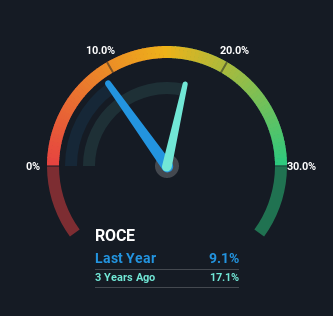To find a multi-bagger stock, what are the underlying trends we should look for in a business? Typically, we’ll want to notice a trend of growing return on capital employed (ROCE) and alongside that, an expanding base of capital employed. Basically this means that a company has profitable initiatives that it can continue to reinvest in, which is a trait of a compounding machine. In light of that, when we looked at Lear (NYSE:LEA) and its ROCE trend, we weren’t exactly thrilled.
Return On Capital Employed (ROCE): What Is It?
For those that aren’t sure what ROCE is, it measures the amount of pre-tax profits a company can generate from the capital employed in its business. Analysts use this formula to calculate it for Lear:
Return on Capital Employed = Earnings Before Interest and Tax (EBIT) ÷ (Total Assets – Current Liabilities)
0.091 = US$744m ÷ (US$13b – US$5.2b) (Based on the trailing twelve months to October 2022).
Therefore, Lear has an ROCE of 9.1%. Ultimately, that’s a low return and it under-performs the Auto Components industry average of 13%.
See our latest analysis for Lear
Above you can see how the current ROCE for Lear compares to its prior returns on capital, but there’s only so much you can tell from the past. If you’d like to see what analysts are forecasting going forward, you should check out our free report for Lear.
So How Is Lear’s ROCE Trending?
On the surface, the trend of ROCE at Lear doesn’t inspire confidence. Over the last five years, returns on capital have decreased to 9.1% from 23% five years ago. However it looks like Lear might be reinvesting for long term growth because while capital employed has increased, the company’s sales haven’t changed much in the last 12 months. It may take some time before the company starts to see any change in earnings from these investments.
The Bottom Line On Lear’s ROCE
To conclude, we’ve found that Lear is reinvesting in the business, but returns have been falling. Since the stock has declined 22% over the last five years, investors may not be too optimistic on this trend improving either. On the whole, we aren’t too inspired by the underlying trends and we think there may be better chances of finding a multi-bagger elsewhere.
If you’d like to know about the risks facing Lear, we’ve discovered 4 warning signs that you should be aware of.
While Lear may not currently earn the highest returns, we’ve compiled a list of companies that currently earn more than 25% return on equity. Check out this free list here.
Have feedback on this article? Concerned about the content? Get in touch with us directly. Alternatively, email editorial-team (at) simplywallst.com.
This article by Simply Wall St is general in nature. We provide commentary based on historical data and analyst forecasts only using an unbiased methodology and our articles are not intended to be financial advice. It does not constitute a recommendation to buy or sell any stock, and does not take account of your objectives, or your financial situation. We aim to bring you long-term focused analysis driven by fundamental data. Note that our analysis may not factor in the latest price-sensitive company announcements or qualitative material. Simply Wall St has no position in any stocks mentioned.
Join A Paid User Research Session
You’ll receive a US$30 Amazon Gift card for 1 hour of your time while helping us build better investing tools for the individual investors like yourself. Sign up here
